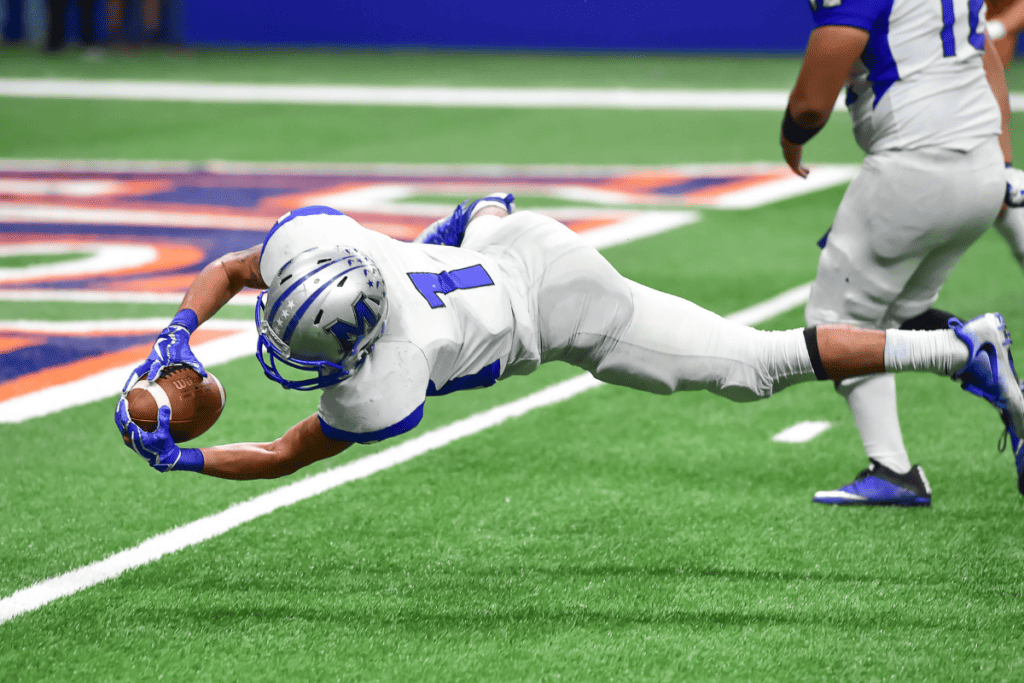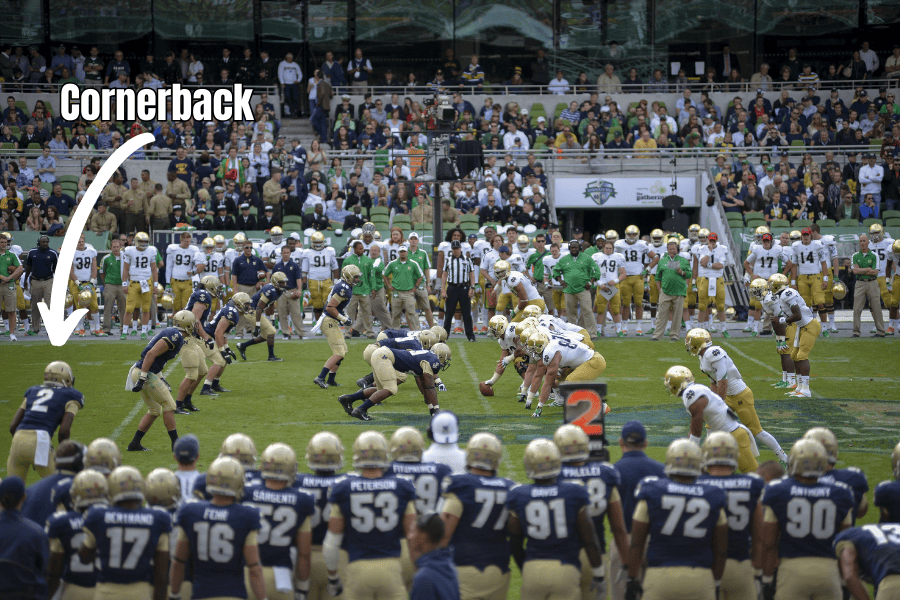Wide Receiver vs Cornerback: The Aerial Duel in Football
In American football, every position on the field plays a crucial role in the success of the team. Among these, the wide receiver and cornerback positions stand out for their direct and often dramatic confrontations during the game.
These roles are central to the passing game – one aiming to advance the ball offensively, and the other focused on defensive prevention. For newcomers to football, understanding the dynamics between these two positions is essential for appreciating the game’s strategic complexities.
This article is designed to shed light on the differences and similarities between wide receivers and cornerbacks, offering insights into their unique yet interconnected roles in football’s aerial battles.
Wide Receiver: A Team’s Offensive Playmaker

The wide receiver is a key figure in a football team’s offensive unit, often seen as the primary playmaker in the passing game. Positioned on the edges of the formation near the sidelines, the wide receiver’s primary role is to run routes and catch passes thrown by the quarterback.
Their objective is to gain as much yardage as possible after the catch, often resulting in significant advances or even touchdowns. Wide receivers are known for their speed and agility, which enable them to create separation from defenders, as well as their precise route-running skills that allow them to find open space on the field.
Their ability to catch the ball consistently, often in challenging situations against tight coverage, makes them indispensable to an effective offense. A successful wide receiver not only possesses physical talents but also an acute understanding of defensive strategies, allowing them to adjust their routes and tactics on the fly.
Crucial Skills for a Dominant Wide Receiver
To be dominant in their role, a wide receiver requires a combination of physical abilities and mental acumen. Speed is paramount for outrunning defenders and creating the necessary separation for catching passes. Agility and quickness are essential for executing precise and complex route patterns to evade defenders.
Hand-eye coordination and catching ability are critical, as wide receivers need to secure passes often while moving at high speeds and sometimes in tightly contested situations. Route-running expertise, which includes understanding various patterns and the ability to adjust based on defensive coverage, is vital.
Additionally, wide receivers must have a strong mental grasp of the game, including the ability to read defenses and make split-second decisions during plays.
Read More:
Cornerback: Defense’s First Line Against the Pass

The cornerback is a key player in a football team’s defensive unit, primarily responsible for defending against the pass. Positioned opposite the wide receivers, cornerbacks are tasked with preventing them from catching the ball.
This role requires them to shadow wide receivers, anticipate routes, and disrupt passing plays by either intercepting the ball or knocking it away. Cornerbacks must possess a blend of speed and agility similar to wide receivers to effectively cover them. They also need excellent reactive skills to adjust to the movements of the wide receiver and the ball. The ability to read the quarterback and anticipate throws is also crucial.
A successful cornerback not only excels in physical skills but also demonstrates strategic intelligence and mental toughness, as they often engage in one-on-one battles where they must quickly recover from setbacks.
Key Abilities for an Effective Cornerback
An effective cornerback must excel in several areas to effectively counter the threats posed by wide receivers. Speed and agility are crucial for keeping up with fast and nimble receivers and for closing gaps quickly. Good anticipation and the ability to read both the receiver and the quarterback are essential for disrupting passes and making interceptions.
Physicality and tackling ability are also important, as cornerbacks may need to engage in physical confrontations with receivers and contribute to stopping the run. Ball skills, including the ability to catch or bat away passes, are key.
Mental resilience is critical, as cornerbacks often find themselves in high-pressure situations where they must maintain confidence and quickly forget about any plays that don’t go in their favor.
Contrasting Dynamics: WR vs CB
Wide receivers and cornerbacks, though they often face each other on the field, have contrasting roles and objectives. Wide receivers are offensive players whose main goals are to catch passes and create scoring opportunities. Their success is measured by their ability to get open, catch the ball, and gain yardage.
Cornerbacks, on the other hand, are defensive players charged with preventing wide receivers from achieving these goals. Their success hinges on their ability to read the play, cover receivers closely, and disrupt or intercept passes. This dynamic creates a compelling cat-and-mouse game on the field, with each player trying to outmaneuver the other.
While their physical skills may be similar, their techniques, strategies, and mental approaches to the game differ significantly, highlighting the diverse skill sets and strategies employed in football.
Shared Attributes of Wide Receivers and Cornerbacks
Despite their adversarial roles on the field, wide receivers and cornerbacks share several common attributes essential for their respective positions. Both require exceptional athletic abilities, including speed and agility, to maneuver effectively during plays.
Quick decision-making is vital for both, as they need to rapidly assess and react to the evolving dynamics of the game. A strong understanding of football tactics and an ability to anticipate the opponent’s moves are crucial for outplaying the opposition.
Moreover, both positions demand excellent hand-eye coordination – wide receivers to catch the ball and cornerbacks to defend or intercept passes. Mental toughness is another shared trait, as both must maintain focus and composure, particularly in high-stakes, one-on-one matchups that can often decide the outcome of a play or game.
The Tactical Battle
The matchup between wide receivers and cornerbacks is a critical and often game-defining aspect of football. It’s a tactical battle where each player’s skills and strategies can significantly influence the game’s direction. Wide receivers must use their route-running skills and speed to create separation and open passing lanes.
At the same time, cornerbacks must employ their coverage techniques and instincts to counter these moves and prevent successful receptions. This ongoing duel requires both positions to constantly adapt and refine their tactics based on the opponent’s strengths and weaknesses.
The outcome of these individual matchups can have a profound impact on the overall effectiveness of the offensive and defensive strategies, making the wide receiver-cornerback battle one of the most intriguing and pivotal aspects of a football game.
Famous Rivalries
Football history is filled with legendary wide receiver-cornerback rivalries that have captivated fans and showcased the sport’s strategic and athletic brilliance. Matchups like Jerry Rice vs. Deion Sanders, Randy Moss vs. Darrelle Revis, and Calvin Johnson vs. Richard Sherman have become iconic, demonstrating the high level of skill and competition between these positions.
These rivalries have not only highlighted individual greatness but have also exemplified the intense strategic battles that occur on the football field.
Conclusion
Understanding the roles and interplay of wide receivers and cornerbacks is essential for anyone looking to appreciate the strategic complexity of football. These positions, with their distinct yet interconnected responsibilities, create some of the most dynamic and exciting moments in the sport.
Wide receivers, with their offensive prowess, and cornerbacks, with their defensive acumen, both play crucial roles in their teams’ success. Recognizing the nuances of these matchups enhances the experience of watching football, offering a deeper insight into the game’s tactical depth and athletic splendor.

